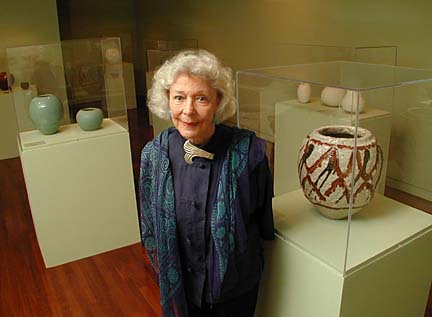Advertisement - Click to support our sponsors.


Sharing a passion
By Suzanne Tswei
for pottery
Special to the Star-BulletinHONOLULU socialite and art patron Phyllis Spalding doesn't remember the year she first saw the pottery of Shimizu Uichi. It was some time in the 1960s. However, she remembers vividly that she knew she had found something special. She had no idea how special.
"His pieces were simply exquisite. But little did I know he'd be declared a living national treasure of Japan. If I had known, I would have borrowed money to buy more of his pots," says the 70-something Spalding.
Born the eldest son of a ceramics wholesaler, Shimizu rejected the family business and took up the uncertain life of a potter when he was 14. Now 73, Shimizu lives and works on the shore of Lake Biwa in Shiga Prefecture, and is revered in Japan for his bold and unconventional artistic style, particular for his mastery of glazes.

Over a span of about 20 years, Spalding traveled to Japan every year and bought a few pieces from Shimizu on each trip. Her accumulation of Shimizu's glazed stoneware vessels is on public display for the first time at The Contemporary Museum, which received the collection as a donation.
ON EXHIBIT
What: "A Classic Elegance: Ceramics by Shimizu Uichi"
Where: The Contemporary Museum, 2411 Makiki Heights Drive
When: 10 a.m. to 4 p.m. Tuesday through Saturday; noon to 4 p.m. Sunday through Jan. 16, closed Christmas and New Year's days
Cost: $5, $3 for seniors and students, free to members and children under 12, free on third Thursday of each month
Call: 526-1322
The collection includes fine examples of the kind of work Shimizu is known for -- the soft persimmon red temmoku (iron oxide) glaze, the crackled white and celadon glazes.
"I do wish I could have bought more," says Spalding, who is a co-owner of Mandalay Imports, a group of high-end resort shops. "His things were never cheap, even back then when I bought them. But I don't think I can afford any now that he is a living treasure."
Spalding visited Asia regularly in the 1960s to hunt for treasures for her interior decorating business in Honolulu. She met Shimizu at his rustic studio in Kyoto after she asked an antiques dealer to show her some pottery. She fell in love with Shimizu's work at first sight.
The language barrier made communication difficult. There were nods and bows, and polite greetings exchanged through the antique dealer. Otherwise, gesturing conveyed the messages. Spalding pointed to the pieces she was interested in, and Shimizu's wife climbed up a ladder to fetch them from shelves that covered the studio from wall to wall and from floor to ceiling.
"I wish I could have gotten to know him better. We couldn't talk to each other, so we didn't really form a relationship." Despite the lack of words, Spalding eventually felt accepted by the Shimizus.
"It took three years. Every year I would go see them and buy some pottery. I would always be standing there. Shimizu's mother, the grand dame of the whole thing, would be sitting and drinking tea. She would be sitting in the middle of the room, on the tatami, with a table in front of her.
"She was very formal, a very regal, beautiful woman. She was the one really in charge of what was going on in that house. Finally, the third year, she invited me to sit on the tatami to have tea with her. She finally thought I was OK. From then on, I got to sit down and have tea."
EVENTUALLY Spalding stopped buying Shimizu's pottery as her travels to Asia became less frequent after her retirement from the decorating business. She lost touch with him but kept the pottery in her personal collection -- not to sell as household decorations to her wealthy clients. The pottery were displayed casually on the oversized ledge around her bath tub, until she received a catalog from Japan saying Shimizu had been declared a living national treasure in 1985.
"I panicked when I found out. I rushed in the bathroom and rescued them so fast. I brought them out (to the living room) and put them on the Ming (dynasty) table."
Two years ago Spalding donated her collection to the museum that once was her family home. Anna Charlotte Rice, founder of the Honolulu Academy of Arts and descendant of one of the early missionary families, built the Makiki Heights home in 1925. The home passed down to her daughter, Alice Cooke Spalding, who became Spalding's mother-in-law. The home was donated to the academy, then sold to a developer and sold again to become the current museum.
Click for online
calendars and events.